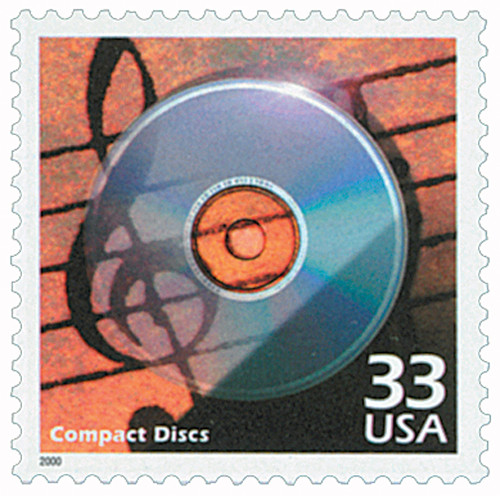
2000 33c Celebrate the Century,1980s: Compact Discs
# 3190h FDC - 2000 33c Celebrate the Century - 1980s: Compact Discs
$2.00 - $2.95
U.S. #3190h
33¢ Compact Discs
33¢ Compact Discs
Issue Date: January 12, 2000
City: Kennedy Space Center, FL
Quantity: 6,000,000
Printed By: Ashton-Potter (USA) Ltd
Printing Method: Lithographed
Perforations: 11.5
Color: Multicolored
City: Kennedy Space Center, FL
Quantity: 6,000,000
Printed By: Ashton-Potter (USA) Ltd
Printing Method: Lithographed
Perforations: 11.5
Color: Multicolored
Compact discs, commonly known as CDs, were introduced in the United States in 1983. By 1986, over one million CD players were being sold each year, making them the fastest-growing consumer-electronic product ever. By the early 1990s, CDs had made vinyl albums obsolete, and started to outsell cassettes. Figures for 1997 show over 70 percent of all recorded music was purchased on CD – cassette tapes were a distant second.
Music stored on a compact disc is in digital form. Digital music requires a great deal of storage space.. A standard computer floppy disc could only store about three seconds of music. Lasers can be focused on a much smaller area than a magnetic head, more information can be placed in a smaller area. On a CD, one second of music can be stored in an area the size of the head of a pin. A music CD can hold a total of 15 billion bits of information, which is equal to about 74 minutes of music. It would take 1,480 floppy discs to hold that much music.
CDs have several advantages over cassettes. They last longer, offer superior quality sound, and enable the listener to select any part of a recording quickly. Because the information on a CD is read by a light beam, playing a CD causes no wear on the recording.
U.S. #3190h
33¢ Compact Discs
33¢ Compact Discs
Issue Date: January 12, 2000
City: Kennedy Space Center, FL
Quantity: 6,000,000
Printed By: Ashton-Potter (USA) Ltd
Printing Method: Lithographed
Perforations: 11.5
Color: Multicolored
City: Kennedy Space Center, FL
Quantity: 6,000,000
Printed By: Ashton-Potter (USA) Ltd
Printing Method: Lithographed
Perforations: 11.5
Color: Multicolored
Compact discs, commonly known as CDs, were introduced in the United States in 1983. By 1986, over one million CD players were being sold each year, making them the fastest-growing consumer-electronic product ever. By the early 1990s, CDs had made vinyl albums obsolete, and started to outsell cassettes. Figures for 1997 show over 70 percent of all recorded music was purchased on CD – cassette tapes were a distant second.
Music stored on a compact disc is in digital form. Digital music requires a great deal of storage space.. A standard computer floppy disc could only store about three seconds of music. Lasers can be focused on a much smaller area than a magnetic head, more information can be placed in a smaller area. On a CD, one second of music can be stored in an area the size of the head of a pin. A music CD can hold a total of 15 billion bits of information, which is equal to about 74 minutes of music. It would take 1,480 floppy discs to hold that much music.
CDs have several advantages over cassettes. They last longer, offer superior quality sound, and enable the listener to select any part of a recording quickly. Because the information on a CD is read by a light beam, playing a CD causes no wear on the recording.












